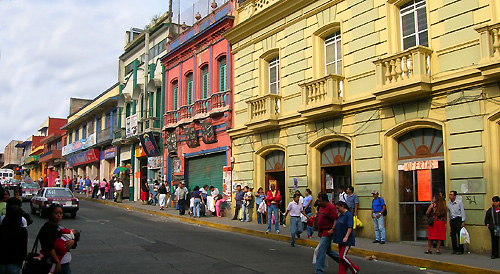 Contacting the musicians of the group Son de Madera turned out to be difficult, as did just about everything else involving communications in Mexico. We found their home town from their My Space page, so we decided to take the bus from Veracruz to Xalapa, up in the mountains, hoping to contact them. It turned out to be a wonderful trip. The buildings of Xalapa are bright and cheerful—a pleasant reflection of the people who live there.
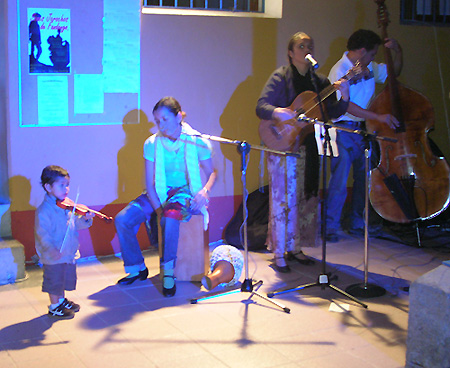 Our first stop in our search for Son de Madera was the music school. On the day we arrived, we discovered that members of the groups Guacamaya and Son de Madera were performing that evening. Quetzel Flores and his wife Martha Gonzales kindly invited us back to their home, where we discussed the rebirth of the Jarana Jarocha tradition and the important contributions of brothers Gilberto and Ramón Guiterrez to that revival. We were able to get a cell phone number for Ramón and arrange a meeting.
Martha's son did an admirable job with his toy violin. Although he didn't actually produce any notes, his bowing technique was impeccable!
 
A long walkway leads to the Patio Muñoz where several houses surround a rectangular patio area. One of the buildings is the workshop of Ramón Guiterez, founder of Son de Madera. Tina speaks with Michel, a neighbor, musician, and friend of Ramón.
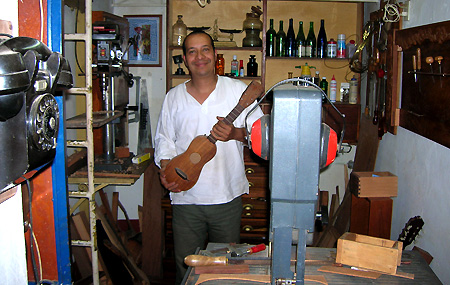
Ramón Guiterrez-Hernandez in one room of his workshop. Many of the tools in his workshop were identical to tools that I use in my own shop here in Cincinnati. He had fewer power tools and relied more on handwork.
I also noticed the absense of sandpaper in his shop. Most of his finish work is done with scrapers, either metal or broken glass, exactly like the luthiers worked in past centuries.
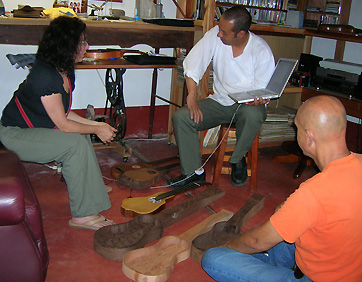
Ramón discusses the different sizes and tunings of Jaranas, using his Mac powerbook to illustrate a point. (The artists we met in Mexico seemed to prefer Apple computers). We worked out the details of the instruments we wanted him to build for us and decided to order two Jaranas--Tercero and Segundo models.
The tradition of carving an instrument from a solid block of wood goes all the way back to the Middle Ages, when the unreliability of glues and a wet climate made it a necessity. The hot, humid climate of Mexico in the summer has produced a similar style of building. In Eastern Europe today, violin-type instruments similar to the Medieval rebec are still being carved from a solid block of wood.
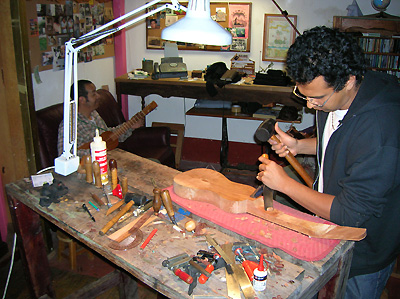 Ramón's apprentice chisels out the neck and body of our jarana. Mahagony (caoba) and Cedar (cedra) are the woods traditionally used for a jarana. Soundboards can be either quarter-sawn or slab cut, and made from Mahagony or cedar. Ramón prefers to use quarter-sawn cedar for his best instruments.

Ramón carefully supervised his apprentice's work while Tina practiced the chords and rhythms Ramón taught her.
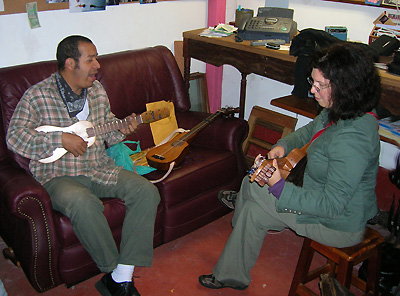
Tina took several lessons from Ramón during the weekends we spent in Xalapa. His knowledge of historical playing styles and his technique were most impressive, on both the jarana and the smaller requinto. To hear his incredible technique, listen to this YouTube recording. Ramón squeezed the lessons in between building sessions. In this photo he plays a Jarana segundo while Tina accompanies his improvised melodies on a Jarana tercero.
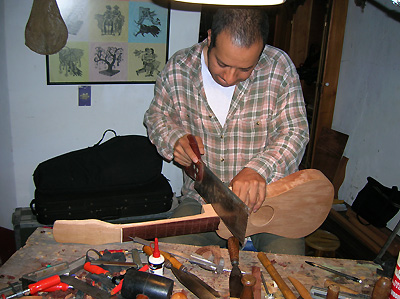
Sawing excess wood from the heel of the neck. The body, neck and pegbox are carved from a single piece of mahagony. The soundboard and fingerboard are glued on separately. This photo was taken the night before the photo below, which shows the same instrument varnished and strung up.
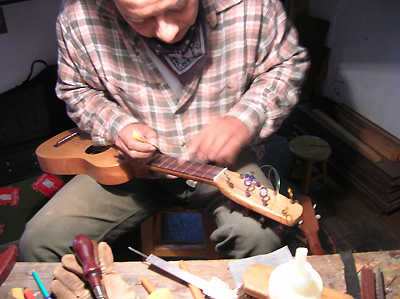
Polishing the frets and fretnut of the finished instrument. In order to complete the two Jaranas we had ordered, Ramón had to pull an all-nighter. On the day we left, he was just able to finish the two instruments and string them up.
 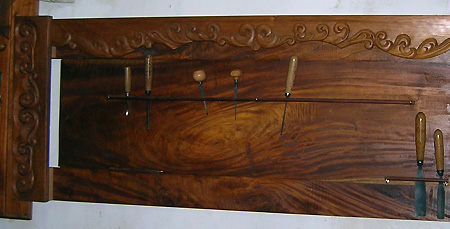
Michel stopped by to work on a fretless banjo he had developed. Ramón designed and built his own stairway, as well as everything else in his shop, including this tool rack.
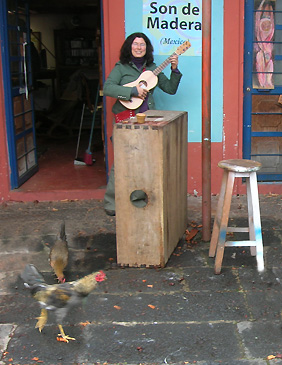 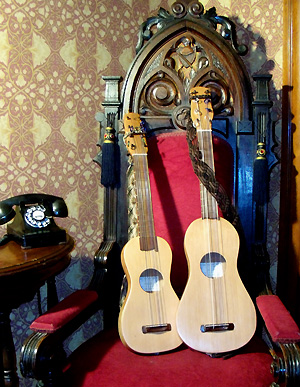
Tina happily playing her finished Jarana. In front of her, standing on its side, is a "tarima", the soundbox used by dancers to amplify their percussive footwork. Ramón often hosts Fandangos in his patio.
The two new Jaranas ended up safely back in our home in Cincinnati after the usual horrors of airline travel. At least we got them back in one piece. On the left is the Jarana Segundo, on the right the Jarana Tercero. Now we need to go back to Mexico to get a Requinto!
| Traveler's Tip
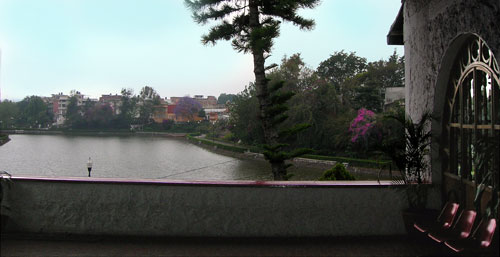 The sole repository for information about the Son tradition and the Jarana seems to be a well-hidden bookshop maintained by the government. It's only open by appointment and doesn't have a phone, so the best I can do is give you directions for finding it. From the historic center of Xalapa, you have to follow the streets that go downward behind the Palacio Municipal, the main government building. Start at the elevated park and go down Herrera two or three blocks to a scenic little lake area called Los Lagos. If you stop to ask directions, prepare to be misled. At the northern end of the lake is a pavilion called the Centro Cultural, used for various events. Inside the center, locked behind a wooden door (no windows), is a little room with a sizable collection of privately-made DVDs and privately published books on the Jarana and the Musica del Son. They even had T-shirts and a Jarana or two for sale there. If you ask anyone about it, they won't know what you are talking about, so ask for the Casa de Artesanias, which is a little street with shops right next to the Cultural Center. This is probably the only way you will find it. It's a charming little street with many small booths and shops where people sell objectos folkloricos, items hand-made by the owners. The woman in charge of the bookshop in the Center is named Tere Osoño. You have to call her in order to get into the room and buy anything. Someone in the Cultural Center may have her cell phone number. Good luck. The sole repository for information about the Son tradition and the Jarana seems to be a well-hidden bookshop maintained by the government. It's only open by appointment and doesn't have a phone, so the best I can do is give you directions for finding it. From the historic center of Xalapa, you have to follow the streets that go downward behind the Palacio Municipal, the main government building. Start at the elevated park and go down Herrera two or three blocks to a scenic little lake area called Los Lagos. If you stop to ask directions, prepare to be misled. At the northern end of the lake is a pavilion called the Centro Cultural, used for various events. Inside the center, locked behind a wooden door (no windows), is a little room with a sizable collection of privately-made DVDs and privately published books on the Jarana and the Musica del Son. They even had T-shirts and a Jarana or two for sale there. If you ask anyone about it, they won't know what you are talking about, so ask for the Casa de Artesanias, which is a little street with shops right next to the Cultural Center. This is probably the only way you will find it. It's a charming little street with many small booths and shops where people sell objectos folkloricos, items hand-made by the owners. The woman in charge of the bookshop in the Center is named Tere Osoño. You have to call her in order to get into the room and buy anything. Someone in the Cultural Center may have her cell phone number. Good luck.
Above is a view of the lake in the Los Lagos area, taken from inside the Cultural Center. |
Part 3: The Requinto. Tunings of the Jarana instruments. The harp. Other instruments.
| 
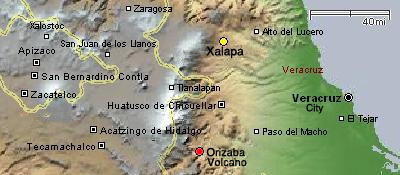















 The sole repository for information about the Son tradition and the Jarana seems to be a well-hidden bookshop maintained by the government. It's only open by appointment and doesn't have a phone, so the best I can do is give you directions for finding it. From the historic center of Xalapa, you have to follow the streets that go downward behind the Palacio Municipal, the main government building. Start at the elevated park and go down Herrera two or three blocks to a scenic little lake area called Los Lagos. If you stop to ask directions, prepare to be misled. At the northern end of the lake is a pavilion called the Centro Cultural, used for various events. Inside the center, locked behind a wooden door (no windows), is a little room with a sizable collection of privately-made DVDs and privately published books on the Jarana and the Musica del Son. They even had T-shirts and a Jarana or two for sale there. If you ask anyone about it, they won't know what you are talking about, so ask for the Casa de Artesanias, which is a little street with shops right next to the Cultural Center. This is probably the only way you will find it. It's a charming little street with many small booths and shops where people sell objectos folkloricos, items hand-made by the owners. The woman in charge of the bookshop in the Center is named Tere Osoño. You have to call her in order to get into the room and buy anything. Someone in the Cultural Center may have her cell phone number. Good luck.
The sole repository for information about the Son tradition and the Jarana seems to be a well-hidden bookshop maintained by the government. It's only open by appointment and doesn't have a phone, so the best I can do is give you directions for finding it. From the historic center of Xalapa, you have to follow the streets that go downward behind the Palacio Municipal, the main government building. Start at the elevated park and go down Herrera two or three blocks to a scenic little lake area called Los Lagos. If you stop to ask directions, prepare to be misled. At the northern end of the lake is a pavilion called the Centro Cultural, used for various events. Inside the center, locked behind a wooden door (no windows), is a little room with a sizable collection of privately-made DVDs and privately published books on the Jarana and the Musica del Son. They even had T-shirts and a Jarana or two for sale there. If you ask anyone about it, they won't know what you are talking about, so ask for the Casa de Artesanias, which is a little street with shops right next to the Cultural Center. This is probably the only way you will find it. It's a charming little street with many small booths and shops where people sell objectos folkloricos, items hand-made by the owners. The woman in charge of the bookshop in the Center is named Tere Osoño. You have to call her in order to get into the room and buy anything. Someone in the Cultural Center may have her cell phone number. Good luck.